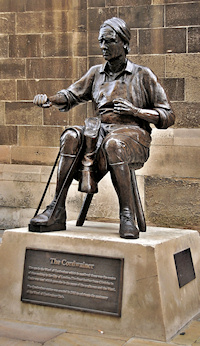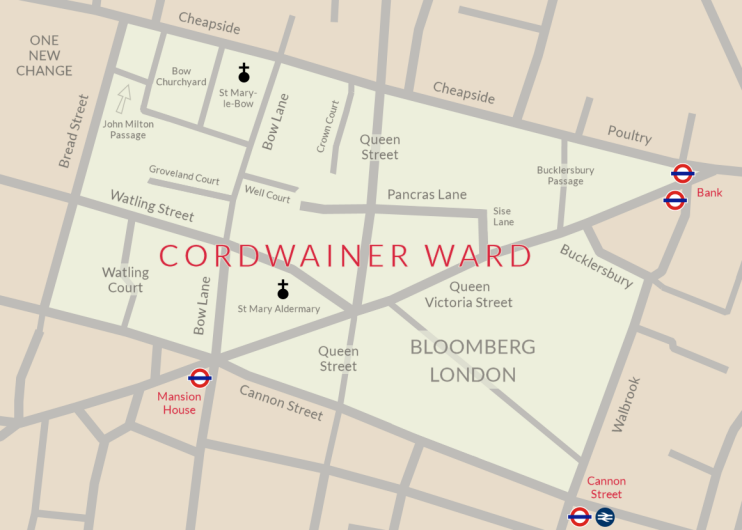Cordwainer
Cordwainer, City of London
One of the City’s smallest wards, bounded by Cheapside and Poultry, Walbrook, Cannon Street and Bread Street

‘Cordwain’ – a corruption of ‘Cordovan’ – was the English word for fine Spanish leather. The Andalusian city of Córdoba was (and to some degree still is) renowned for the manufacture of supple yet strong and waterproof leather.
London’s cordwainers were shoemakers (and originally other leather workers too) and many of them plied their trade in what is now Bow Lane but in the Middle Ages was called Cordwainer’s Street – which was also the name of the ward.
The Guild of Cordwainers was in existence by 1272 and obtained a royal charter in 1439. The last incarnation of the Cordwainers’ livery hall (which was not in the ward of Cordwainer) was destroyed in the Blitz and the Worshipful Company of Cordwainers is nowadays a tenant at Clothworkers’ Hall, which is over to the east in Tower ward.
The ward takes in two grade‑I listed Wren churches: St Mary Aldermary and the most famous of all the City’s churches (not counting a certain cathedral) – St Mary-le-Bow.
The nicest part of Cordwainer lies between the two St Marys: a mostly pedestrianised group of narrow streets and alleys crowded with places to shop, eat and drink – including Williamson’s Tavern in Groveland Court.
Elsewhere, the ward is dominated by the usual City mix of financial sector institutions and their ancillary service providers. The aggressively postmodern office and retail complex called No 1 Poultry stands at Cordwainer’s north-east corner.
The built environment of Cordwainer has undergone significant change over the past decade, culminating in the construction of the European headquarters for the New York-based business and financial information company Bloomberg LP. The scheme fills almost the entire south-east quadrant of the ward and consists of two buildings – one very large and one positively monolithic – each ten storeys tall, plus three subterranean levels. The pair are separated by a pedestrian arcade and connected by several bridges. Museum of London archaeologists uncovered more than 14,000 artefacts at the construction site and went so far as to nickname it ‘the Pompeii of the North’.
Cordwainers College, where Jimmy Choo honed his shoemaking skills, is now part of the London College Fashion.
Alma Boyes’s bronze statue of a cordwainer at work (shown above) was commissioned in 2002 by the City of London Corporation and the Ward of Cordwainer Club to mark the club’s centenary. It was unveiled in Bow Churchyard before its relocation to a permanent home in the newly paved area of Watling Street beside St Mary Aldermary church.
Postal district: EC4
Websites: Ward of Cordwainer Club, London Details: Cordwainer

